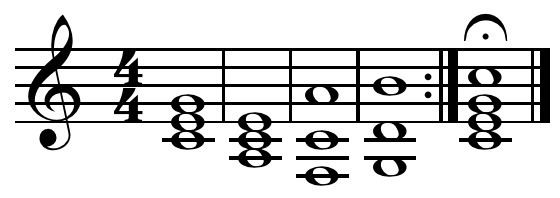 | ||
The '50s progression is a chord progression and turnaround used in Western popular music. The progression, represented in Roman numeral analysis, is: I–vi–IV–V. For example, in C major: C–Am–F–G. As the name implies, it was common in the 1950s and early 1960s and is particularly associated with doo-wop.
Contents
It has also been called the "Heart and Soul" chords, the "Stand by Me" changes, the doo-wop progression and, according to Mike Aquino and Hank Green, the "ice cream changes". The first song to use the sequence extensively might have been "Blue Moon", written in 1933 by Richard Rodgers, and first released, with lyrics by Lorenz Hart, in 1934.
Theory
In Western classical music during the common practice period, chord progressions are used to structure a musical composition. The destination of a chord progression is known as a cadence, or two chords that signify the end or prolongation of a musical phrase. The most conclusive and resolving cadences return to the tonic or I chord; following the circle of fifths, the most suitable chord to precede the I chord is a V chord. This particular cadence, V–I, is known as an authentic cadence. However, since a I–V–I progression is repetitive and skips most of the circle of fifths, it is common practice to precede the dominant chord with a suitable predominant chord, such as a IV chord or a ii chord (in major), in order to maintain interest. In this case, the 50s progression uses a IV chord, resulting in the ubiquitous I–IV–V–I progression. The vi chord before the IV chord in this progression (creating I–vi–IV–V–I) is used as a means to prolong the tonic chord, as the vi or submediant chord is commonly used as a substitute for the tonic chord, and to ease the voice leading of the bass line: in a I–vi–IV–V–I progression (without any chordal inversions) the bass voice descends in major or minor thirds from the I chord to the vi chord to the IV chord.
Variations
As with any other chord progression, there are many possible variations, for example turning the dominant or V into a V7, or repeated I–vi progression followed by a single IV–V progression. A very common variation is having ii substitute for the subdominant, IV, creating the progression I–vi–ii–V (a variant of the circle progression) and thus the ii–V–I turnaround.
Variations include switching the vi and the IV chord to create I–IV–vi–V, as is used in "More Than a Feeling" by Boston and "She Drives Me Crazy" by Fine Young Cannibals. This is also similar to the I–V–vi–IV progression.
The harmonic rhythm, or the pace at which the chords occur, may be varied including two beats (half-measure) per chord ( Play ), four ( Play ) (full measure or bar), eight ( Play ) (two measures), and eight beats per chord except for IV and V(7) which get four each ( Play ).
"Sleep Walk" by Santo & Johnny uses a similar progression, with the IV replaced by its parallel minor iv for an overall progression of I–vi–iv–V.
Examples
Well-known examples include the Penguins' "Earth Angel" (1954), Ben E. King's "Stand By Me" and Gene Chandler's "Duke of Earl" (1962). Other examples include Sam Cooke's "Lovable" and other doo-wop material of the era. A modern example can be found in Green Day's "Jesus of Suburbia". Many more recent examples exist, such as Neutral Milk Hotel's "In the Aeroplane over the Sea".. The progression is also the basis for the verses of The Bangles' 1989 hit "Eternal Flame". Madonna's 1986 single "True Blue" is written in the 50s progression. More notable recent examples are Daughtry's "What About Now", Sean Kingston's "Beautiful Girls" and Rebecca Black's "Friday".
The A-section of the song "Heart and Soul" is often simplified as a repeating I–vi–ii–V or I–vi–IV–V progression (or even both variants, alternating) and taught to beginning piano students as an easy two-hand duet. This (somewhat inaccurate) version of the song became widely known, even to those who never studied piano. ( example ).
Walter Everett argues that, "despite the unusual surface harmonic progressions," in The Beatles' "Strawberry Fields Forever" (1967), "the structural basis of the song is I–VI–IV–V–I [sic]." The chorus of The Beatles' "Happiness Is a Warm Gun" is an example of the fifties progression.
In the musical Grease, the progression is invoked for the purpose of self-parody in the song "Those Magic Changes". The chorus includes a backup vocal line with lyrics "C-C-C-C-C-C / A-A-A-A-minor / F-F-F-F-F-F / G-G-G-G-seven" (repeat).
Hank Green of the Vlogbrothers created a song showing the number of songs featuring the progression, including one of his own. It was featured in one of his videos and was also performed at the Evening of Awesome.
The 50s progression is also commonly used in reggae, including Bob Marley’s “Stir It Up,” “Brand New Second Hand” and “Rocksteady.”
